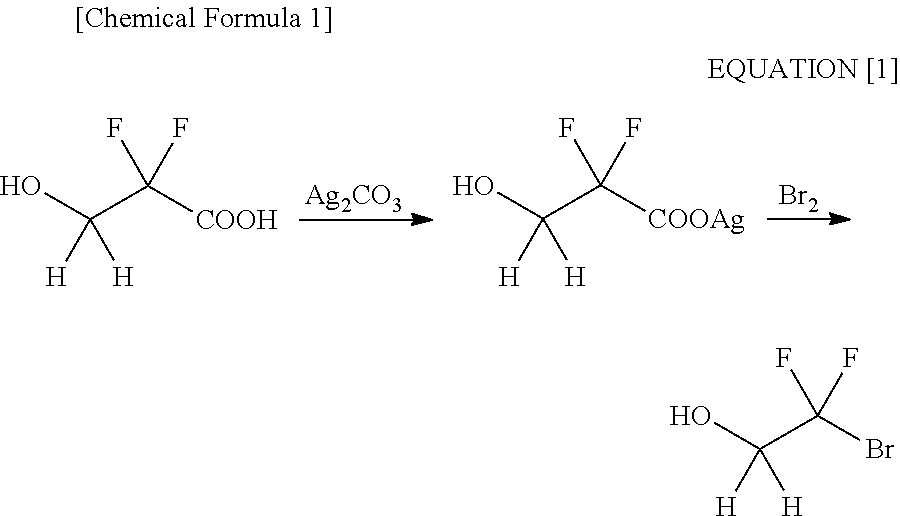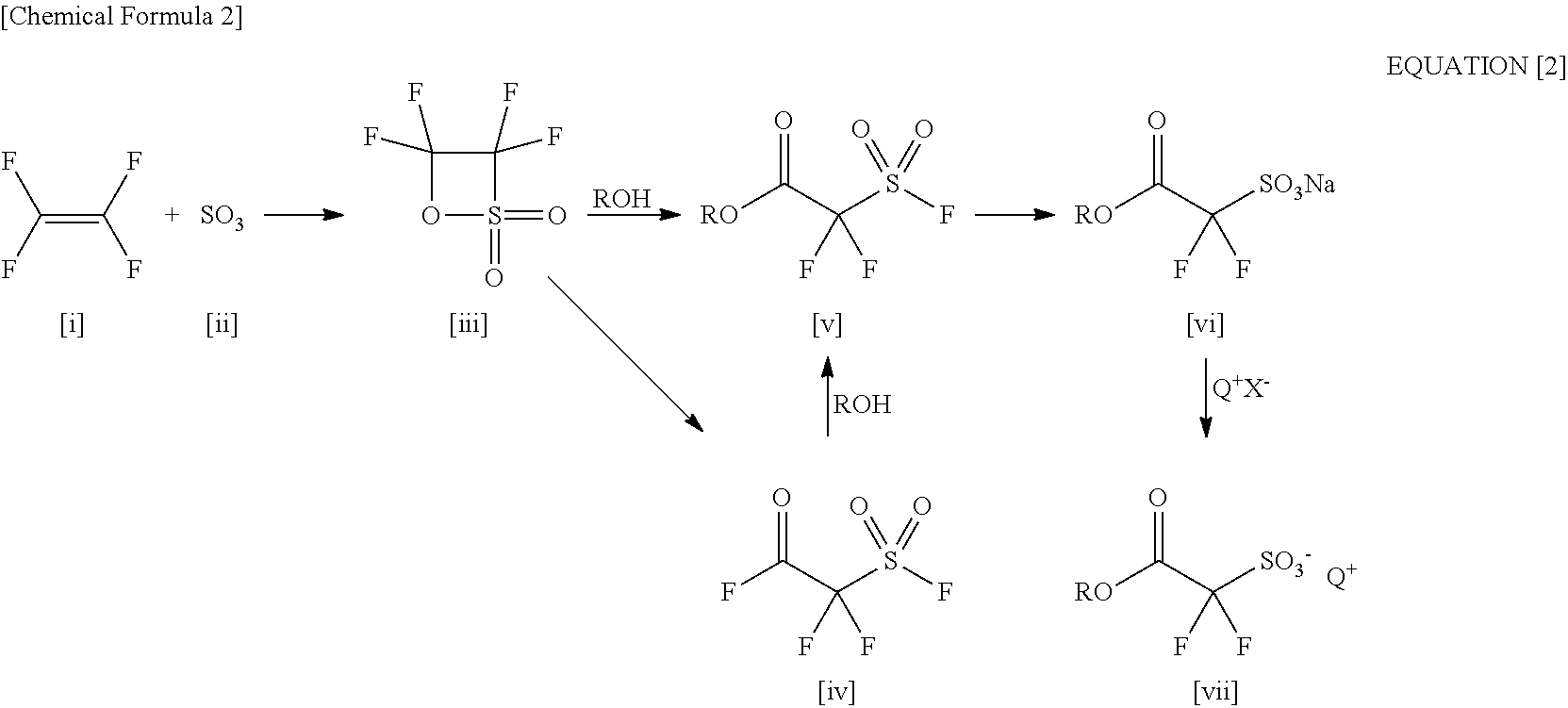Processes for Production of 2-Bromo-2,2-Difluoroethanol and 2-(Alkylcarbonyloxy)-1,1-Difluoroethanesulfonic Acid Salt
a technology of difluoroethylene and ethanesulfonic acid, which is applied in the field of processes for production of 2bromo2, 2difluoroethanol and 2(alkylcarbonyloxy)1, 1difluoroethanesulfonic acid salt, can solve the problems of high chemical reaction risk of tetrafluoroethylene [i] and the danger of explosion, and achieves less operational burden
- Summary
- Abstract
- Description
- Claims
- Application Information
AI Technical Summary
Benefits of technology
Problems solved by technology
Method used
Image
Examples
example 1
Production of 2-bromo-2,2-difluoroethanol
A 1st Step; a Reduction Step
[0175]A glass flask equipped with a thermometer, a condenser and a dropping funnel was charged with 186 g (4.91 moles) of sodium borohydride, 425 g (13.2 moles) of methanol and 3 L of diisopropyl ether, followed by stirring. Then, a diisopropyl ether solution (1 L) of 1000 g (4.92 moles) of ethyl bromodifluoroacetate was added thereto dropwise in an iced bath. After the termination of the dropping, stirring was conducted for 1 hour at room temperature. Then, the termination of the reaction was confirmed by gas chromatography. The reaction solution was separated into an organic layer and a water layer after the addition of 2.5 L of 2N hydrochloric acid, followed by extracting the water layer with 500 ml of diisopropyl ether. Subsequently, the organic layer was rinsed with 500 ml of saturated sodium hydrogencarbonate and 500 ml of saturated brine. Upon drying with anhydrous sodium sulfate, a solvent was distilled off...
example 2
Production of 2-bromo-2,2-difluoroethanol
A 1st Step: a Reduction Step
[0176]A glass flask equipped with a thermometer, a condenser and a dropping funnel was charged with 6 g (29.6 millimoles) of ethyl bromodifluoroacetate and 25 g of dehydrogenated diglyme, followed by stirring. Then, 1.5 g (39.5 millimoles) of lithium aluminohydride (LiAlH4) was added thereto. It was heated to 60° C. and stirred for 12 hours, followed by cooling to room temperature, and then extraction was carried out thereon with the addition of diisopropyl ether and hydrochloric acid (1M). Upon separating into two layers, an organic layer was rinsed with saturated sodium bicarbonate water, saturated brine and water, followed by drying with magnesium sulfate. After filtration, a solvent was distilled off under a reduced pressure, thereby obtaining 3.8 g of the target 2-bromo-2,2-difluoroethanol (80% yield, 95% purity).
example 3
Production of 2-bromo-2,2-difluoroethanol
A 1st Step: a Reduction Step
[0177]A glass flask equipped with a thermometer, a condenser and a dropping funnel was charged with 27 g (140 millimoles) of ethyl bromodifluoroacetyl chloride and 200 g of tetrahydrofuran, followed by stirring. Then, 5.0 g (132 moles) of sodium borohydride (NaBH4) was added thereto. It was heated to 60° C. and stirred for 16 hours, followed by cooling to room temperature, and then extraction was carried out thereon with the addition of diisopropyl ether and hydrochloric acid (1M). Upon separating into two layers, an organic layer was rinsed with saturated sodium bicarbonate water, saturated brine and water, followed by drying with magnesium sulfate. After filtration, a solvent was distilled off under a reduced pressure, thereby obtaining 19.2 g of the target 2-bromo-2,2-difluoroethanol (85% yield, 96% purity).
PUM
| Property | Measurement | Unit |
|---|---|---|
| wavelength | aaaaa | aaaaa |
| solubility | aaaaa | aaaaa |
| acid strength | aaaaa | aaaaa |
Abstract
Description
Claims
Application Information
 Login to View More
Login to View More - R&D
- Intellectual Property
- Life Sciences
- Materials
- Tech Scout
- Unparalleled Data Quality
- Higher Quality Content
- 60% Fewer Hallucinations
Browse by: Latest US Patents, China's latest patents, Technical Efficacy Thesaurus, Application Domain, Technology Topic, Popular Technical Reports.
© 2025 PatSnap. All rights reserved.Legal|Privacy policy|Modern Slavery Act Transparency Statement|Sitemap|About US| Contact US: help@patsnap.com



